HOME > Exhibitions > Past
-
Special Exhibition
A Tea Gathering with the Irises Screens
An Assemblage from May, 1937 - Saturday, April 16 - Sunday, May 15, 2022
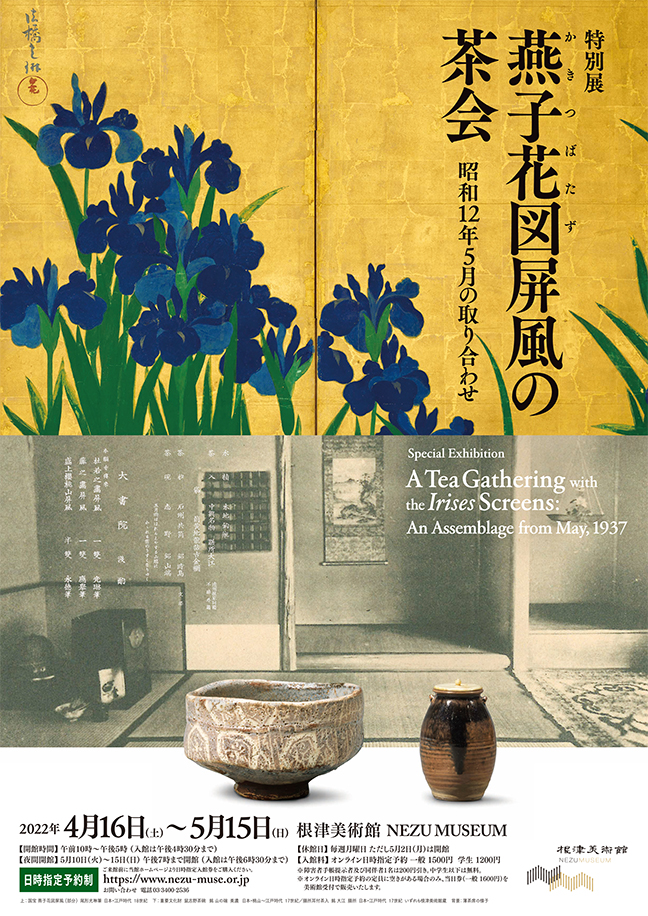

| Closed | Mondays, except May 2 |
|---|---|
| Hours |
10 a.m. - 5 p.m.(last entry: 4:30 p.m.) 10 a.m. - 7 p.m. May 10-15 (last entry: 6:30 p.m.) |
| General admission | Adult 1500 yen, Student 1200 yen |
| Gallery | 1/2 |
Nezu Kaichirō, Sr. (tea name Seizan; 1860-1940), who laid the foundations of the Nezu Museum collection, would invite friends to his residence in Aoyama and occasionally display the Irises folding screens, by Ogata Kōrin. Here we recreate the tea assemblage he arranged for a May, 1937, tea gathering adorned by the Irises folding screens. Kaichirō would serve thick tea and kaiseki cuisine in his tea room, the Ikaruga An, and thin tea in the large sitting room attached to it. Later, he also organized flower-viewing events, at which he displayed the Irises in his reception room. This tea assemblage, which includes the Incense Container with Irises in Fans Design and the Writing Box with a Portrait of Narihira, attributed to Ogata Kōrin, gives a glimpse of how he selected works associated with the Irises and entertained his friends.
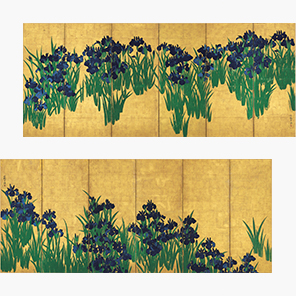

- Irises
- By Ogata Kōrin
-
Japan Edo period, 18th century
Nezu Museum - Clusters of iris flowers are rendered in varying intensities of azurite blue and malachite green against a gold ground. The contrasting composition of the left and right screens and the rhythmical arrangement of the motif at first glance stand out for their decorative, design-like qualities, but the plump depiction of the flower petals also cannot be overlooked. The scene is believed to have been inspired by the scenic spot of Yatsuhashi (Eight Bridges) in Mikawa Province, which was famed for irises and celebrated in poetry by the protagonist of the Tales of Ise.
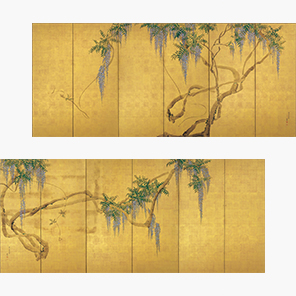

- Wisteria
- By Maruyama Ōkyo
-
Japan Edo period, dated 1776
Nezu Museum - This image depicts wisteria vines on a solid gold background. The trunks and branches are rendered uninhibitedly in the tsuketate technique with no outlines, but at the same time variations in light and dark ink create a rich sense of three-dimensionality. The layering of white, blue, and purple pigments in the flowers is almost reminiscent of Western Impressionist painting. By fusing traditional Japanese-style yamato-e painting and the decorative nature of Rinpa with new techniques, the artist expresses the life’s breath of his subject.
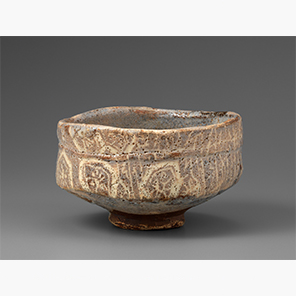

- Tea Bowl, named Yamanoha
- Mino ware
-
Japan Momoyama-Edo periods, 17th century
Nezu Museum - Nezumi-shino type wares are created by applying oniita, an iron-rich slip, and then a feldspar glaze before firing. In this example, the hexagonal motifs and brush fence motifs on the sides of the bowl were created using sgraffito, scratching away part of the oniita slip. The botanical motif on the interiorwas produced in the same way. The bowl’s name Yamanoha, literally “mountain ridge”, derives from the cloud-like appearance of the bowl’s white glaze.
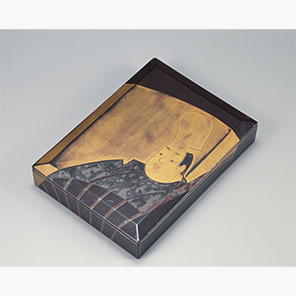
- Writing Box with Design of Portrait of Narihira
- Attributed to Ogata Kōrin
-
Japan Edo period, 18th century
Nezu Museum - A gold, folding fan-format arch stretches across the top of the lid of this writing box, with a half-length image of Ariwara no Narihira, dressed in gold-toned court hat and black kariginu robes, set against that fan-format background. While today this work cannot be confirmed as done by Kōrin’s own hand, it was published in Ikeda Koson’s Kōrin shinsen hyakuzu and is an important tool in our understanding of Kōrin’s role as a maki-e lacquer designer.










